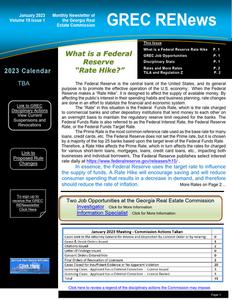GGRREECC RREENNeewwss January 2023
Volume 19 Issue 1
Monthly Newsletter of the Georgia Real
Estate Commission
# 1
2023 Calendar
TBA
Link to GREC Disciplinary Actions
View Current Suspensions and
Revocations
Link to Proposed Rule
Changes
To sign up to receive the GREC
RENewsletter Click Here
This Issue What is a Federal Reserve Rate Hike GREC Job Opportunities Disciplinary Stats Rates and More Rates TILA and Regulation Z
P. 1 P. 1 P. 1
P. 2 P. 2
The Federal Reserve is the central bank of the United States, and its general
purpose is to promote the effective operation of the U.S. economy. When the Federal
Reserve makes a "Rate Hike", it is designed to affect the supply of available money. By
affecting the public's interest in their spending habits and business planning, rate changes
are done in an effort to stabilize the financial and economic system.
The "Rate" in this situation is the Federal Funds Rate, which is the rate charged
to commercial banks and other depository institutions that lend money to each other on
an overnight basis to maintain the regulatory reserve limit required for the banks. The
Federal Funds Rate is also referred to as the Federal Interest Rate, the Federal Reserve
Rate, or the Federal Funds Target Rate.
The Prime Rate is the most common reference rate used as the base rate for many
loans, credit cards, etc. The Federal Reserve does not set the Prime rate, but it is chosen
by a majority of the top 25 banks based upon the target level of the Federal Funds Rate.
Therefore, a Rate Hike affects the Prime Rate, which in turn affects the rates for charged
for various short-term loans, mortgages, loans, credit card loans, etc., impacting both
businesses and individual borrowers. The Federal Reserve publishes select interest
rate daily at https://www.federalreserve.gov/releases/h15/ .
In essence, the Federal Reserve uses the target rate to influence
the supply of funds. A Rate Hike will encourage saving and will reduce
consumer spending that results in a decrease in demand, and therefore
should reduce the rate of inflation.
More Rates on Page 2...
Two Job Opportunities at the Georgia Real Estate Commission Investigator Click for More Information Information Specialist Click for More Information
Click Here
Click here to review a legend of the disciplinary actions the Commission may impose.
Page 1
SUBMIT
Comments &
Suggestions
H
Online Courses from GREC
$10 each 3 Hour CE
Course
Total of 9 Hours CE Available (Approved as License Law
CE and approved as Instructor CE)
"Avoiding Trust
Account Trouble"
"Practicing Real Estate & Staying Out of Trouble"
"Being a Broker and Staying Out of Trouble"
Click Here
Georgia Real Estate Commission Suite 1000 International Tower 229 Peachtree Street NE Atlanta, GA 30303-1605 Phone 404-656-3916
GREC RENews January 2023, Volume 19 Issue 1
Rates and More Rates
Interest is the total sum paid or accrued for the use of money. Interest Rate is usually quoted as an annual percentage charged/paid for the loan
or paid/received on a deposit, and is dependent on the prime rate, the type of financing, the length of term of financing, the business cycle availability for funds, and economic conditions. Annual Percentage Rate (APR) is not interest but does include interest. "Credit costs may vary depending on the interest rate, the amount of the loan and other charges, the timing and amounts of advances, and the repayment schedule. The APR, which must be disclosed in nearly all consumer credit transactions, is designed to take into account all relevant factors and to provide a uniform measure for comparing the cost of various credit transactions. The APR is a measure of the cost of credit, expressed as a nominal yearly rate. It relates the amount and timing of value received by the consumer to the amount and timing of payments made." i "The Finance Charge is a total monetary measure of the cost of consumer credit .It includes loan points, loan service fees, mortgage broker fees, required credit insurance, required closing agent/3rd part fees, private mortgage insurance, Life of Loan chares such as flood, and taxes) and other fees that may be considered finance charges". i The Prime Rate is an interest rate determined by individual banks. It is often used as a reference rate (also called the base rate) for many types of loans, including loans to small businesses and credit card loans.
Truth In Lending Act (TILA) and Regulation Z
The Truth in Lending Act (TILA) was enacted on May 29, 1968, as title I of the
Consumer Credit Protection Act.
The TILA is implemented by Regulation Z and became effective July 1, 1969.
"The Truth in Lending Act is intended to ensure that credit terms are disclosed in a
meaningful way so consumers can compare credit terms more readily and
knowledgeably. Before its enactment, consumers were faced with a bewildering
array of credit terms and rates. It was difficult to compare loans because they were
seldom presented in the same format. Now, all creditors must use the same credit
terminology and expressions of rates. In addition to providing a uniform system for
disclosures, the act is designed to:
Protect consumers against inaccurate and unfair credit billing and credit
card practices;
Provide consumers with rescission rights;
Provide for rate caps on certain dwelling-secured loans; and
Impose limitFatoiocnus sonohnomTee remquinityolliongesy:of c"rRedaitteand certain closed-end
home mortgages." i
"
Most practitioners of residential real estate are very familiar with Regulation Z and its
required disclosures in closing statements and loan transactions. Most Credit extended
primarily for a business, commercial, or agricultural purposes are exempt from
Regulation Z. Further detail regarding specific disclosures and exemptions can be found
at the following resource links:
i https://www.federalreserve.gov/boarddocs/caletters/2008/0805/08-
05_attachment1.pdf
https://www.federalregister.gov/truth-in-lending-regulation-z-
Page 2
